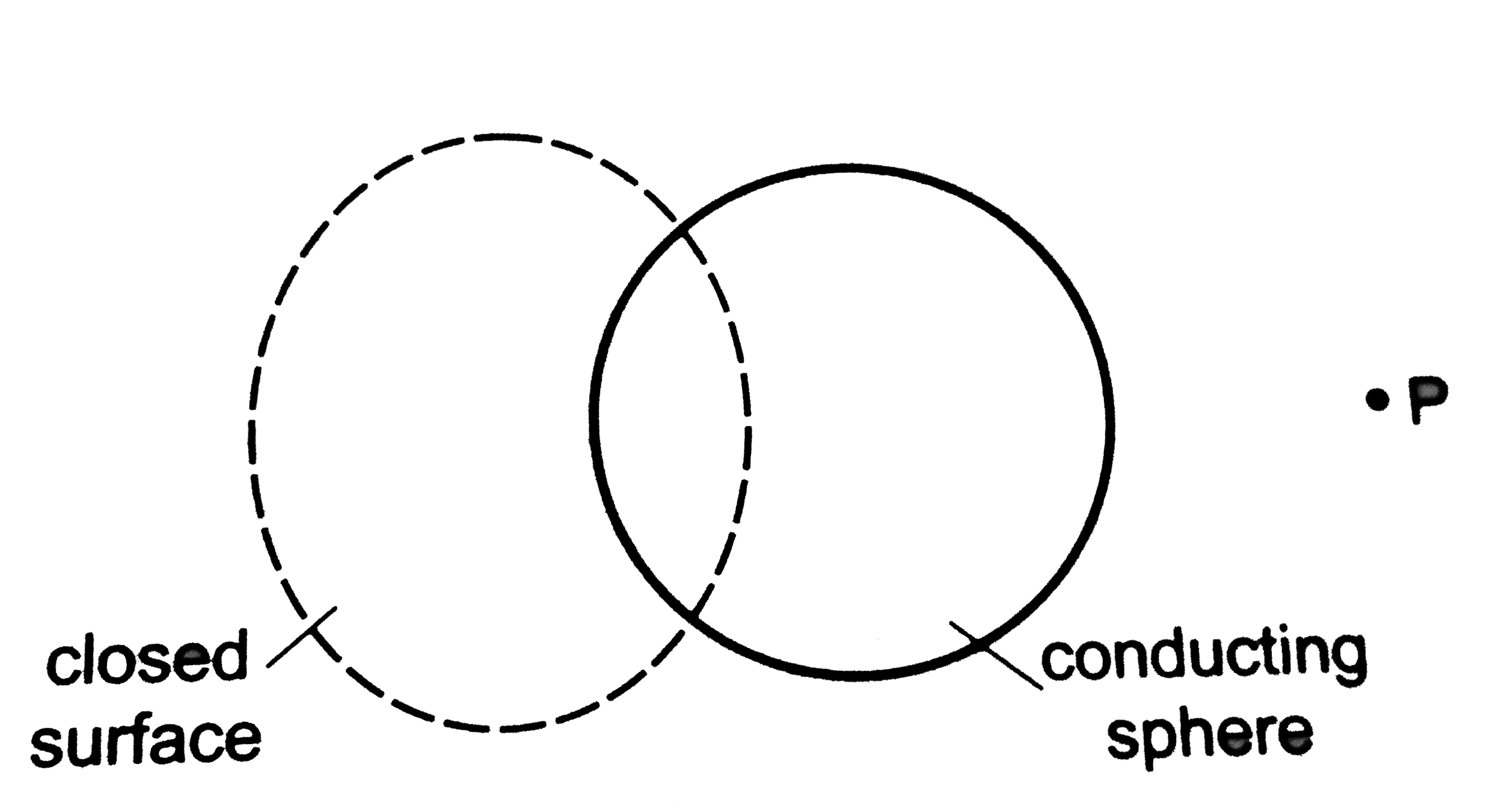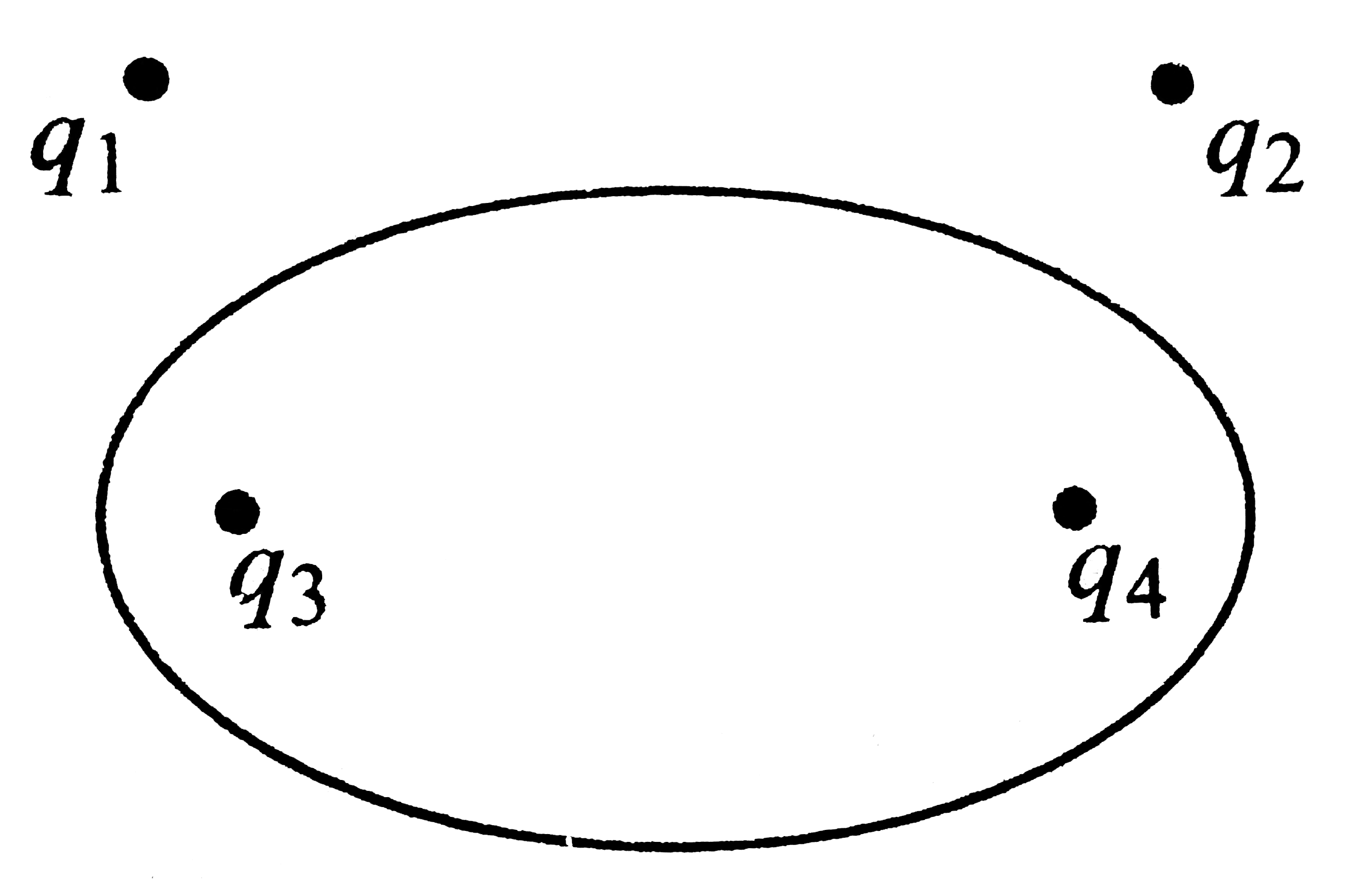If the flux of the electric field through a closed surface is zero,
the electric field must be zero everywhere on the surface
the electric field may be zero everywhere on the surface
the charge inside the surface must be zero
the charge in the vicinity of the surface must be zero.
The correct Answer is:B, C
To solve the question, "If the flux of the electric field through a closed surface is zero," we can analyze the implications of this statement using Gauss's Law.
1. Understanding Electric Flux:
Electric flux (Φ) through a closed surface is defined as the integral of the electric field (E) over the surface area (A):
Φ=∮E⋅dA
According to Gauss's Law, this is also equal to the charge (Q) enclosed by the surface divided by the permittivity of free space (ε₀):
Φ=Qencϵ0
2. Given Condition:
The problem states that the electric flux through the closed surface is zero:
Φ=0
3. Implication of Zero Flux:
From Gauss's Law, if the flux is zero, then:
Qencϵ0=0
This implies that the enclosed charge (Q_enc) must be zero:
Qenc=0
4. Electric Field on the Surface:
The statement does not necessarily mean that the electric field (E) is zero everywhere on the surface. The electric field can be present, but it can also be such that the total number of electric field lines entering the surface equals the number of lines exiting, resulting in a net flux of zero.
5. Conclusion:
Therefore, the conclusions we can draw are:
- The charge inside the closed surface must be zero (Q_enc = 0).
- The electric field may or may not be zero everywhere on the surface; it can be non-zero but still yield zero net flux.
Summary of Findings:
- Charge inside the surface must be zero: This is a confirmed statement.
- Electric field may be zero everywhere on the surface: This is a possible scenario.
- Electric field must be zero everywhere on the surface: This is not necessarily true.
- Charge in the vicinity of the surface must be zero: This is incorrect; charges can exist outside the surface and still yield zero flux.
Electric flux (Φ) through a closed surface is defined as the integral of the electric field (E) over the surface area (A):
Φ=∮E⋅dA
According to Gauss's Law, this is also equal to the charge (Q) enclosed by the surface divided by the permittivity of free space (ε₀):
Φ=Qencϵ0
The problem states that the electric flux through the closed surface is zero:
Φ=0
From Gauss's Law, if the flux is zero, then:
Qencϵ0=0
This implies that the enclosed charge (Q_enc) must be zero:
Qenc=0
The statement does not necessarily mean that the electric field (E) is zero everywhere on the surface. The electric field can be present, but it can also be such that the total number of electric field lines entering the surface equals the number of lines exiting, resulting in a net flux of zero.
Therefore, the conclusions we can draw are:
- The charge inside the closed surface must be zero (Q_enc = 0).
- The electric field may or may not be zero everywhere on the surface; it can be non-zero but still yield zero net flux.
- Charge inside the surface must be zero: This is a confirmed statement.
- Electric field may be zero everywhere on the surface: This is a possible scenario.
- Electric field must be zero everywhere on the surface: This is not necessarily true.
- Charge in the vicinity of the surface must be zero: This is incorrect; charges can exist outside the surface and still yield zero flux.
Topper's Solved these Questions
- BOOK - HC VERMACHAPTER - GAUSS LAWEXERCISE - Exercises24videos
GAUSS LAW
- BOOK - HC VERMACHAPTER - GAUSS LAWEXERCISE - Objective 17videos
GAUSS LAW
- BOOK - HC VERMACHAPTER - ELECTROMAGNETIC WAVESEXERCISE - Exercises9videos
ELECTROMAGNETIC WAVES
- BOOK - HC VERMACHAPTER - GEOMETRICAL OPTICSEXERCISE - Exercises79videos
GEOMETRICAL OPTICS
Similar Questions
Find the flux of the electric field through each of the five surfaces of the inclined plane as shown in figure. What is the total flux through the entire closed surface?
 View Solution
View SolutionElectric charge are distributed in a small vouume. The flux of the electric field through a spherical surface of rasius 10cm surrounding the total charge is 25 V m. The flux over a concentric sphere of radius 20 cm will be
View Solution
Knowledge Check
- Question 1 - Select One
Figure shown a closed surfce which intersects a conducting sphere. If a positive charge is placed at the point P, the flux of the electric field through the closed surface
 Awill remain zeroBwill become positiveCwill become negativeDwill become undefined.
Awill remain zeroBwill become positiveCwill become negativeDwill become undefined. - Question 2 - Select One
A capacitor of capacitance C is charged to a potential V. The flux of the electric field through a closed surface enclosing the capacitor is
ACVεB2CVε0CCV2esψlon0Dzero - Question 3 - Select One
Figure shows four charges q1,q2,q3,andq4 fixed is space. Then the total flux of the electric field through a closed surface S, due to all the charges, is
 Anot equal to the total flux through S due to q3andq4Bequal to the total flux through S due to q3andq4Czero if q1+q2=q3+q4Dtwice the total flux through S due to q3andq4ifq1+q2=q3+q4.
Anot equal to the total flux through S due to q3andq4Bequal to the total flux through S due to q3andq4Czero if q1+q2=q3+q4Dtwice the total flux through S due to q3andq4ifq1+q2=q3+q4.
A Gaussian surface in the cylinder of cross-section πa2 and length L is immersed in a uniform electric field E with the cylinder axis parallel to the field. The flux ϕ of the electric field through the closed surface is
View SolutionAnswer questions on the basis of your understanding of the following paragraph and the related studied concept.
Electric flux, in general , through any surface is defined as per relation:
ϕE=∫→E.→ds , where integration has to be performed over the entire surface through which flux is required. The surface under consideration may be a closed one or an open surface. When flux through a closed surface is required we use a small circular sign on the integration symbol. Thus flux over a closed surface ∮E=∮→E.→ds. it is customary to take the outward normal as positive in this case.
A German physicist Gauss established a fundamental law to find electric flux over a closed surface. As per Gauss' law , the flux of the net electric field through a closed surface equals the net charge enclosed by the surface divided by ∈0.Mathematically ∮→E.→ds=1∈0[qen] , where qcn is the net charge enclosed within the surface. It is possible to derive Gauss' law from Coulomb's laws. Gauss' law can be applied to obtain electric field at a point due to continuous charge distribution for a number of symmetric charge configurations.
What is the electrical flux through a cube of side 'a' if a point charge 'q' is placed at one of its vertices?View SolutionAnswer questions on the basis of your understanding of the following paragraph and the related studied concept.
Electric flux, in general , through any surface is defined as per relation:
ϕE=∫→E.→ds , where integration has to be performed over the entire surface through which flux is required. The surface under consideration may be a closed one or an open surface. When flux through a closed surface is required we use a small circular sign on the integration symbol. Thus flux over a closed surface ∮E=∮→E.→ds. it is customary to take the outward normal as positive in this case.
A German physicist Gauss established a fundamental law to find electric flux over a closed surface. As per Gauss' law , the flux of the net electric field through a closed surface equals the net charge enclosed by the surface divided by ∈0.Mathematically ∮→E.→ds=1∈0[qen] , where qcn is the net charge enclosed within the surface. It is possible to derive Gauss' law from Coulomb's laws. Gauss' law can be applied to obtain electric field at a point due to continuous charge distribution for a number of symmetric charge configurations.
A charge q is enclosed by a Gaussian spherical surface of raidus R. If the radius is doubled then the electric flux will.View SolutionIf the net electric flux through a closed surface is zero, then we can infer
View SolutionA capacitor of capacitance C is connected to a cell of emf V and when fully charged, it is disconnected. Now the separation between the plates is doubled. The change in flux of electric field through a closed surface enclosing the capacitor is
View Solution

